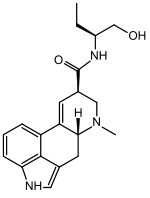Methylergometrine
Methylergometrine (also called methylergonovine, methylergobasin, and D-lysergic acid 1-butanolamide) is a synthetic analogue of ergometrine, a psychedelic alkaloid found in ergot, and many species of morning glory. It is a member of the ergoline family and chemically similar to LSD, ergine, ergometrine, and lysergic acid. Due to its oxytocic properties, it has a medical use in obstetrics. According to Jonathan Ott, methylergonovine has LSD-like actions above 2 milligrams, due to its agonistic action at the 5HT2A-mGlu2 receptor protomers. Clinical efficacy occurs around 200 µg, ten times lower than the hallucinogenic threshold.
 | |
| Clinical data | |
|---|---|
| Trade names | Methergine |
| Other names | Methylergobasine Methylergobrevin Methylergonovine |
| AHFS/Drugs.com | International Drug Names |
| MedlinePlus | a601077 |
| Pregnancy category |
|
| Routes of administration | Oral |
| ATC code | |
| Legal status | |
| Legal status |
|
| Pharmacokinetic data | |
| Metabolism | Liver |
| Elimination half-life | 30–120 min |
| Excretion | Mostly bile |
| Identifiers | |
IUPAC name
| |
| CAS Number | |
| PubChem CID | |
| IUPHAR/BPS | |
| ChemSpider | |
| UNII | |
| ChEMBL | |
| CompTox Dashboard (EPA) | |
| ECHA InfoCard | 100.003.661 |
| Chemical and physical data | |
| Formula | C20H25N3O2 |
| Molar mass | 339.432 g/mol g·mol−1 |
| 3D model (JSmol) | |
| Melting point | 172 °C (342 °F) |
| Solubility in water | insoluble mg/mL (20 °C) |
SMILES
| |
InChI
| |
| | |
Methylergometrine maleate is marketed under the trade name Methergine.
Uses
Obstetric use
Methylergometrine is a smooth muscle constrictor that mostly acts on the uterus. It is most commonly used to prevent or control excessive bleeding following childbirth and spontaneous or elective abortion, and also to aid in expulsion of retained products of conception after a missed abortion (miscarriage in which all or part of the fetus remains in the uterus) and to help deliver the placenta after childbirth. It is available as tablets or injection (IM or IV) or in liquid form to be taken orally.[1][2][3]
Migraine
Methylergometrine is sometimes used for both prevention[4] and acute treatment[5] of migraine. It is an active metabolite of methysergide.
Contraindications
Methylergometrine is contraindicated in patients with hypertension and preeclampsia.[1] It is also contraindicated in HIV positive patients taking protease inhibitors, delavirdine and efavirenz (which is also an agonist at the 5HT2A-mGlu2 receptor protomer and increases the chances of a patient experiencing hallucinations during methylergometrine therapy).[6]
Side effects
Adverse effects include:[1]
- Cholinergic effects such as nausea, vomiting, and diarrhea
- Dizziness
- Pulmonary hypertension
- Coronary artery vasoconstriction
- Severe systemic hypertension (especially in patients with preeclampsia)
- Convulsions
In excessive doses, methylergometrine can also lead to cramping, respiratory depression and coma.[1]
Interactions
Methylergometrine likely interacts with drugs that inhibit the liver enzyme CYP3A4, such as azole antifungals, macrolide antibiotics and many HIV drugs. It can also increase constriction of blood vessels caused by sympathomimetic drugs and other ergot alkaloids.[1]
Mechanism of action
Methylergometrine is a partial agonist/antagonist on serotonergic, dopaminergic and alpha-adrenergic receptors. Its specific binding and activation pattern on these receptors leads to a highly, if not completely, specific contraction of smooth uterus muscle via 5-HT2A serotonin receptors,[7] while blood vessels are affected to a lesser extent compared to other ergot alkaloids.[1]
See also
References
- Jasek, W, ed. (2007). Austria-Codex (in German) (62nd ed.). Vienna: Österreichischer Apothekerverlag. pp. 5193–5. ISBN 978-3-85200-181-4.
- Mutschler, Ernst; Schäfer-Korting, Monika (2001). Arzneimittelwirkungen (in German) (8 ed.). Stuttgart: Wissenschaftliche Verlagsgesellschaft. p. 447. ISBN 3-8047-1763-2.
- Fachinformation des Arzneimittel-Kompendium der Schweiz: Methergin (in German)
- Koehler, PJ; Tfelt-Hansen PC (Nov 2008). "History of methysergide in migraine". Cephalalgia. 28 (11): 1126–35. doi:10.1111/j.1468-2982.2008.01648.x. PMID 18644039.
- Niño-Maldonado, Alfredo; Gary Caballero-García; Wilfrido Mercado-Bochero; Fernando Rico-Villademoros; Elena P Calandre (8 Nov 2009). "Efficacy and tolerability of intravenous methylergonovine in migraine female patients attending the emergency department: a pilot open-label study". Head Face Med. 5 (21). doi:10.1186/1746-160X-5-21. PMC 2780385. PMID 19895705.
- "Methylergonovine Maleate Monograph for Professionals - Drugs.com". drugs.com. Archived from the original on 2016-09-20.
- Heinz Pertz, Eckart Eich (1999). "Ergot alkaloids and their derivatives as ligands for serotoninergic, dopaminergic and adrenergic receptors". In Vladimír Křen,Ladislav Cvak (ed.). Ergot: the genus Claviceps. CRC Press. pp. 411–440. ISBN 978-905702375-0.